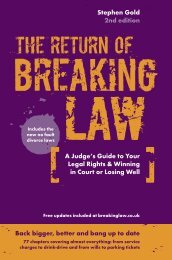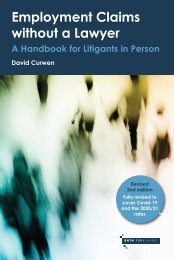Insolvency Made Clear: A Guide for Debtors
Plain English, practical guidance for anyone facing demands over a debt they are struggling to pay.
Plain English, practical guidance for anyone facing demands over a debt they are struggling to pay.
Create successful ePaper yourself
Turn your PDF publications into a flip-book with our unique Google optimized e-Paper software.
<strong>Insolvency</strong> Law <strong>Made</strong> <strong>Clear</strong> – A <strong>Guide</strong> For <strong>Debtors</strong><br />
The name of a legal case is usually underlined, bold or in italics to distinguish<br />
it from the names of the people involved. For example, Donoghue v Stevenson<br />
refers to the case between a Mrs Donoghue and a Mr Stevenson. After the first<br />
instance, it is common to refer to a case using just one of the names, <strong>for</strong> example<br />
simply Donoghue.<br />
The ‘CPR’ are the Civil Procedure Rules 1998: http://www.justice.gov.uk/courts/<br />
procedure-rules/civil/rules.<br />
Alongside the CPR, there are civil procedure Practice Directions (‘PD’) which<br />
are, in effect, further rules of civil procedure.<br />
The ‘IR’ are the <strong>Insolvency</strong> (England and Wales) Rules 2016: https://www.legislation.gov.uk/uksi/2016/1024/contents/made.<br />
The ‘CDDA’ is the Company Directors Disqualification Act 1986: https://www.<br />
legislation.gov.uk/ukpga/1986/46/contents.<br />
The ‘OR’ is the Official Receiver (see above).<br />
The ‘PR’ is the Personal Representative (see above).<br />
xxviii













